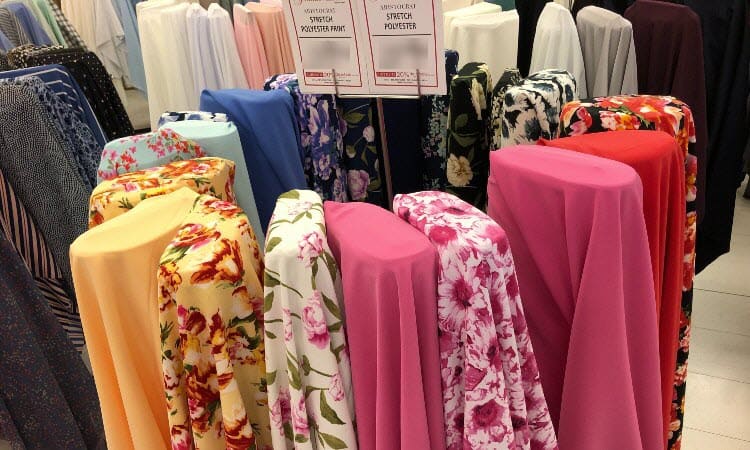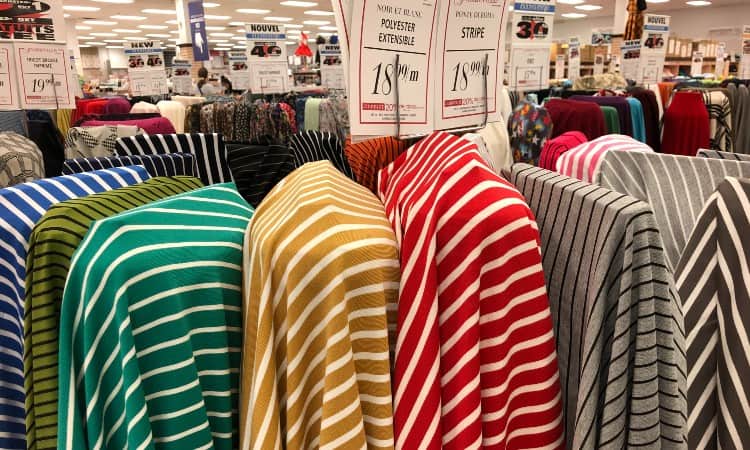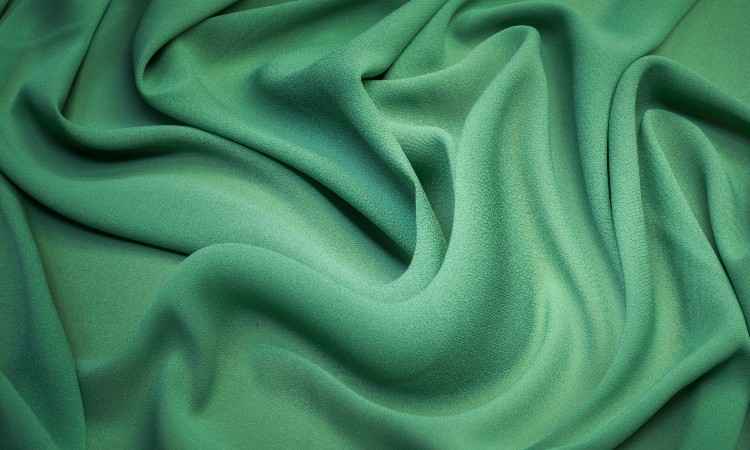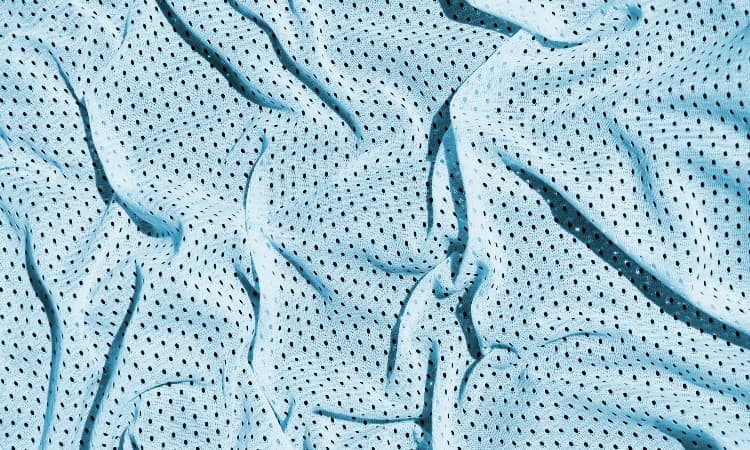More than half of all the clothes sold every year contain polyester. If you find this tough to believe, check the tags inside your clothes! You can find many different polyester fabric types, which makes it a versatile material.
Different types of polyester fabric, like PET and PCDT, depend on the chemical structure of the cloth. Polyester fabric types can also depend on the construction of the cloth, such as the difference between plain weave and satin weave. Some types of polyester fabrics also feature sportswear abilities like moisture wicking.
In this article, you will learn the key characteristics of polyester. You will discover the most popular different polyester fabric types. Finally, you will find out which types of polyester work best for clothing.

What is Polyester?
Polyester is a type of synthetic fabric made out of the by-products of petroleum, with a special chemical structure featuring repeating ester functional groups. The substance itself is a type of polymer or plastic. Textile factories can turn pools of this plastic substance into fine yarns that polyester fabric can look and feel like satin, cotton, or stretchy t-shirt fabric.
Production
As an entirely man-made fabric, polyester goes through a multi-stage manufacturing process.
- Just like when drilling for oil, massive drills dig down into the earth to locate petroleum.
- Big refineries then extract a variety of petroleum by-products by adding solvents and exposing the petroleum to heat.
- To make PET, the most popular form of polyester for clothing, manufacturers put the chemicals through a polymerization process. This creates a plasticky, honey-like goop by mixing various chemicals like TPA and ethylene glycol.
- The key stage in translating the basic building block of polyester polymers into fibers that can form fabric is the extrusion process. During this stage, nozzles squirt out the liquid substance into fine spinnerets. The threads cool down and harden into fine fibers.
- Finally, spinning machines twist many fibers together to form yarn. Manufacturers can then use many different weaving techniques to turn the polyester yarns into different styles of cloth.
Texture
Polyester fabric can have many different textures depending on its construction. One of the reasons this fabric gained such massive popularity is its extreme versatility, allowing it to form so many different types and feels of fabrics.
- Polyester woven in a basic plain weave, where the yarns cross over and under each other like a woven basket, will have a smooth, sleek texture. Polyester yarns lack the breathability of cotton because the yarns contain plastic polymers instead of porous, natural fibers, but this material will still feel soft and comfortable.
- Polyester woven with a satin weave will have a silky, shinier texture made by crossing multiple weft threads over each warp thread. This type of fabric can make gorgeous wedding gowns or fancy bed sheets.
- Polyester cloth made by knitting fine loops of yarns together can form jersey knit for a soft, springy t-shirt material.
- Polyester fabric made on special double looms can create velvet by using a pile weave that creates two layers of fabric at once and then uses a sharp blade to slice them apart.
The bottom line here is that polyester can transform into many different types of cloth, each with a distinct texture, depending on the kind of weaving pattern used to construct the fabric.
Uses
Popular uses for polyester fabric include anything you can make from cloth, including clothing, coats, bed sheets, upholstery, carpets, awnings, and curtains. Polyester also has many industrial uses in things like rope and machine parts.
In terms of clothing, you can find either 100% polyester or a blend of polyester and other fabrics in everything from suits to t-shirts to maxi dresses.
Price
Polyester fabric costs less than natural fabrics like cotton, silk, or linen. But the specific price of a garment depends on many factors besides its fabric content, such as the brand and style of the apparel.
In general, though, 100% polyester garments will cost less than any other type of fabric used in clothes. This is because the synthetic production of polyester costs less than growing, harvesting, and processing natural fibers into fabric.
Different Polyester Fabric Types

Manufacturers can use slight variations in the chemical structure of the polymers inside polyester to create different types of material, like the difference between PET and PCDT polyester. You can also find different types of polyester fabric that use unique processes to turn the polymers into fibers, such as the difference between fiber and tow polyester.
PET (Ethylene Polyester)
The type of polyester most commonly used to make clothing is called Ethylene Polyester, Polyethylene Terephthalate, or PET. The source material for this fabric is ethylene which comes from petroleum, but it goes through a complex manufacturing process in which ethylene polymers hold together other chemicals to form fibers.
Manufacturers use four common methods to create fabric with this material. These four types of polyester come from using the filament, staple, tow, and fiberfill methods of manufacturing.
- Polyester filament fabric contains long, fine, continuous fibers. But because polyester is essentially a plastic, even these superfine strands feel like a finer version of a fishing line and do not produce the softest fabric.
- Staple or spun polyester uses both chemicals and agitation to soften the fibers. Plus, staple polyester uses many short fibers twisted together into yarns before weaving the cloth. These processes form a much softer, though less durable, type of polyester.
- Polyester tow is roughly broken up fibers often used as stuffing. It is also a way to incorporate recycled polyester back into the fabric.
- Fiberfill polyester uses long, unbroken strands of fibers fluffed up with air to fill a large volume of space, like the inside of a pillow.
Plant-Based Polyester
Plant-based polyester contains the same chemicals as PET polyester, but in this case, environmentally conscious manufacturers source ethylene out of natural products like cane sugar. Unlike all other types of polyester, the plant-based kind can biodegrade.
But it costs way more to make plant-based polyester than the regular PET type, making it, unfortunately, far less popular in the clothing industry.
PCDT Polyester
PCDT polyester has a slightly different chemical makeup from PET. PCDT stands for poly-cyclohexylene-dimethylene-terephthalate. (You can see why manufacturers use an acronym!).
This type of polyester has more elasticity and great durability than PET but does not work as well for items like clothing. Instead, it is used primarily for curtains, upholstery, or heavy-duty commercial items.
Polyester Fabrics Examples
Besides its low cost, the main reason polyester has such a wide appeal is its versatility. For example, polyester can form knit fabrics such as jersey knit for t-shirts or sweatshirt fleece. But it can also form woven fabrics like satin or percale bed sheets.
Check out these examples of a few fabric types you can make using polyester!
Jersey Knit
 One of the most popular types of fabric to make out of cotton and polyester is jersey knit, a stretchy, soft cloth made using a single set of needles creating a weft knit pattern of loops that tall face in the same direction in the cloth. Knit fabrics have extra stretch because the loops of yarn inside the cloth can expand and contract much more easily than woven threads. This is one of the reasons jersey knit achieved global popularity as a t-shirt fabric!
One of the most popular types of fabric to make out of cotton and polyester is jersey knit, a stretchy, soft cloth made using a single set of needles creating a weft knit pattern of loops that tall face in the same direction in the cloth. Knit fabrics have extra stretch because the loops of yarn inside the cloth can expand and contract much more easily than woven threads. This is one of the reasons jersey knit achieved global popularity as a t-shirt fabric!
You can find a lot of controversy over whether or not polyester jersey knit t-shirts feel as comfortable and work as well as cotton t-shirts. Both types of cloth have pros and cons because polyester provides better moisture-wicking and cotton offers more breathability and softness. The deciding factor often comes down to the fact that polyester t-shits cost much less than cotton tees!
Microfiber
 Microfiber usually contains 100% polyester, though it sometimes features a blend of rayon-like substances. This newer form of polyester fabric has one unique characteristic that can make it super soft and strong at the same time, which is that it must use very fine threads.
Microfiber usually contains 100% polyester, though it sometimes features a blend of rayon-like substances. This newer form of polyester fabric has one unique characteristic that can make it super soft and strong at the same time, which is that it must use very fine threads.
Because of this, microfiber quality is described by its GSM, or grams per square meter. Fabric with a high GSM of 100 or so has many threads in its weave, making it soft, comfortable, and strong. Microfiber with a lower GSM will have a weak structure and feel less comfortable, though, because it uses these thin threads but does not pack enough of them into every inch of the cloth.
Flannel
 Polyester flannel goes through a two-part construction process. First, it is woven into either a plain weave or a twill weave pattern. Second, it undergoes a napping session on one or both sides of the cloth.
Polyester flannel goes through a two-part construction process. First, it is woven into either a plain weave or a twill weave pattern. Second, it undergoes a napping session on one or both sides of the cloth.
Some factories use rollers to rough up one side of the fabric, breaking free many fine fibers to form a soft, plush surface. Others use wire brushes to create the same effect. This is how flannel gets its characteristic velvety feel!
Polyester flannel for items like pajamas and cold-weather bedding sells quite well and costs less than traditional cotton flannel. That said, polyester flannel can feel too warm in some cases because it does not have the same breathability as cotton flannel.
Satin
 Manufacturers turn polyester yarns into luxurious glossy satin by using a special weaving technique in which multiple weft threads cross over every warp thread. This forms a sleek, shimmery surface on the top side of the cloth.
Manufacturers turn polyester yarns into luxurious glossy satin by using a special weaving technique in which multiple weft threads cross over every warp thread. This forms a sleek, shimmery surface on the top side of the cloth.
Traditionally, clothmakers used silk threads to make satin. But silk has a prohibitive cost today and often, only high-end luxury brands offer true satin made out of silk anymore. Instead, synthetic substitutes like polyester make a great stand-in.
Velvet
 Velvet made out of polyester has one of the most interesting weaving methods of all types of fabrics because it uses a double-loom construction. This means that the factory weaves two lengths of velvet at the same time, with looms on top and bottom like the bread in a sandwich.
Velvet made out of polyester has one of the most interesting weaving methods of all types of fabrics because it uses a double-loom construction. This means that the factory weaves two lengths of velvet at the same time, with looms on top and bottom like the bread in a sandwich.
The fibers that connect the two pieces of cloth in the middle, like the filling in the sandwich, turn into a thick, fuzzy pile of velvet when a sharp blade slices between the two looms, separating the two pieces of velvet.
Even though it costs much less to make velvet out of polyester than out of traditional silk, polyester velvet still costs a lot more than polyester jersey knit because of the complex weaving process.
Blended Fabrics
Another common way to create fabric out of polyester is to blend different types of fabric fibers together. This lets you pick and choose the best qualities of different fabric types, such as the silkiness of rayon, the softness of cotton, and the durability of polyester.
- Polycotton blends cotton and polyester fibers to form a popular blended fabric for t-shirts and other apparel. You can find 50/50 blends of polyester and cotton or other percentages like 40/60.
- Poly-wool blends polyester with wool. This fabric often shows up in apparel like off-the-rack suits.
- Triblends mix together three types of fabric fiber,s usually polyester, cotton, and rayon. This forms a softer and lighter type of fabric than a simple polycotton blend.
What is 100% Polyester Fabric?

Pure 100% polyester fiber has unique characteristics like excellent durability, wrinkle resistance, and water resistance. While its texture depends on the weaving method used, it does tend to have a coarser feel than natural fabrics.
- One of the advantages of a synthetic fabric like polyester is that it has great durability and will not fade, wear out, or tear easily. This also makes it easy to care for more polyester garments because you can machine-wash them without worrying about damage to the material.
- Polyester also holds onto its shape well, which helps prevent wrinkling. This makes it a great choice for off-the-rack clothing because it will not require constant care and ironing. On the other hand, you do have to take some care because polyester can melt under high heat if you choose to iron it.
- Polyester works well for athletic clothing because it resists absorbing moisture. This allows it to “moisture-wick” or quickly move moisture from one side of the fabric to the other to evaporate into the air. Unlike types of fabric that will get soggy when you sweat, polyester will not soak up the sweat.
- In general, polyester tends to have a coarser and more plastic-like feel than other types of material. High-quality polyester manufactured carefully and woven using certain techniques can closely mimic the feel of cotton or silk, though, so this does depend on the processes used to produce the polyester.
- Another negative characteristic of polyester is that it is not biodegradable and adds to plastic pollution globally.
What is the Most Commonly Used Polyester?
The most commonly used type of polyester is PET or Ethylene Polyester. Of course, as you now know, you can make many different types of fabric using PET! The most popular type of cloth made out of polyester is jersey knit or t-shirt fabric.
Polyester fabric dominates the clothing industry and has significantly outpaced cotton cloth, which has now fallen into the second most popular clothing fabric worldwide.
Types of Polyester Fabric for Sportswear

Sportswear fabrics made of polyester can serve several different purposes, such as moisture-wicking during intense workouts or ease of movement during flexible activities like yoga.
Some of the most popular types of polyester fabric for sportswear include:
- Polyester mesh is an open-weave fabric that has visible gaps in its structure. You see this type of sports fabric used in vent areas on clothing or anywhere you want a lot of air circulation. Because of all the holes in the fabric, the mesh also stretches well and provides flexibility in a garment.
- Jersey knit fabric blended with elastic fibers such as Lycra, elastane, or Spandex makes great close-fitting sportswear like leggings. Yoga pants and tank tops often feature this flexible, stretchy material as well. You can also find sportswear made entirely out of Lycra or Spandex for extra cling, but these items do not feel as soft or allow air circulation the way a polyester blend does.
- Polyester microfiber is also popular for athletic apparel because it often feels softer and more lightweight than older versions of polyester fabric. The densely packed fine threads in this cloth protect from the elements and can moisture-wick better than many other types of cloth.
- Certain outdoor sports fabrics provide wind and water-resistant coatings on the fabric’s surface. For instance, a jogging jacket meant to work in most types of weather might have a PU coating to give it a plastic shell of protection from the elements.
- For cold weather sports, you can also find a wide range of fleecy fabrics made out of polyester that you can wear while running or jogging. This works well because, unlike cotton, the poly-fleece will not soak up your sweat and freeze around you! Instead, it will wick the moisture away into the air.
What is the Best Type of Polyester?

The best type of polyester fabric depends on the intended use of the cloth because sports apparel requires different types of fabric than evening wear or bedding. The good news about polyester is that you can find a type of polyester cloth to fit almost any need!
But is there a difference between high-quality and low-quality polyester? Absolutely.
For example, a polyester fabric made using the staple or spinning method to form yarns will feel much softer than filament polyester.
Poor-quality polyester feels like a plastic tablecloth or a ripstop nylon tent–it has a sort of crinkly, coarse texture to it. High-quality polyester, in contrast, will closely mimic a natural fabric in look and texture, such as silk or cotton.
On the consumer side, you can easily check a few spots in a polyester garment to find out if it is high quality or low quality.
- Look at the seams, or lines of stitching, inside the garment. If you see crooked stitches or loops of threads hanging loosely from the stitches, it is low-quality. Good quality stitching on a good-quality polyester fabric has straight lines, small stitches, and no gaps or bubbles of thread.
- Check the buttonholes on shirts, jackets, or pants. If they have a thin, raggedy line of stitches around the edge of the hole, the hole will stretch and skew easily. Look for sturdy buttonhole finishings.
- In some cases, the hem can also give you hints about the quality of the fabric or the garment’s construction. If a garment has a single-fold hem and a row of topstitching to hold it in place, it will not last as long or look as nice as a more professional hem, like a double-fold fold hem double-stitched into place (as you would see on most good t-shirts) or an invisible hem, like you can find on good dresses, skirts, and trousers.
Conclusion
Polyester comes from the byproducts of petroleum and has a versatile nature. It can make fabric for bedding, apparel like t-shirts, and sportswear. In fact, more than half of all the clothing sold in the world contains polyester.
Different types of polyester include ethylene polyester/PET, PTCD, and plant-based polyester. These versions use different chemical structures inside the polymers that compose the fabric. Fabrics like polycotton blend polyester with other types of fibers.